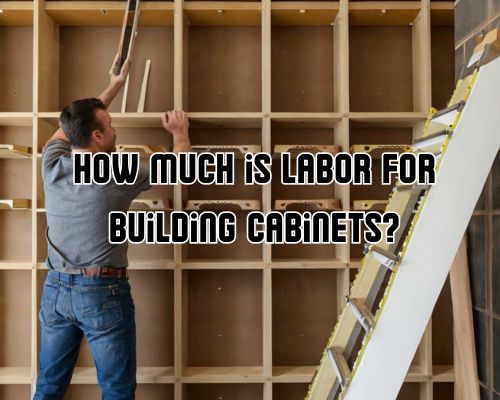How Much Is Labor for Building Cabinets? A Complete Guide for Homeowners in Mornington, Australia

How Much Is Labor for Building Cabinets? A Complete Guide for Homeowners in Mornington, Australia
If you’re planning a home renovation or kitchen upgrade in Mornington, Australia, you might be asking: how much is labor for building cabinets? Cabinetry is one of the most defining elements of any kitchen or bathroom, not just in style but in functionality and value. And while the material cost is often top of mind, labor can account for a significant portion of your overall budget.

With Leona Rodriguesi of Mornington Cabinet Makers, we’ll break down the labor costs for custom cabinet installation and building in Mornington, discuss what affects pricing, compare options (custom vs prefab), and offer insights to help you make a smart investment in your property.
📍 Local Snapshot: Cabinet Building in Mornington, VIC
Mornington, a coastal suburb on the Mornington Peninsula, is known for its elegant homes, contemporary renovations, and beachside charm. With a steady demand for property enhancements, particularly in kitchen and bathroom design, professional cabinetry is a thriving industry in the region. Homeowners are increasingly turning to local cabinet makers and joiners to create bespoke solutions that align with Mornington’s modern-meets-coastal aesthetic.
💰 Average Labor Costs for Cabinet Building in Mornington
In Mornington, labor for building cabinets typically ranges between $75 to $120 per hour, depending on several factors, including the complexity of the project, the experience of the cabinetmaker, and the size of the job.
On average, custom-built cabinet labor can cost between $2,500 to $7,500 for a medium-sized kitchen. For a basic bathroom vanity or laundry setup, expect labor to be around $800 to $2,000. Larger or more intricate projects like butler’s pantries, integrated wardrobes, or entertainment units may command a higher price.
🔍 Factors That Influence Cabinet Labor Costs
Let’s unpack the key variables that affect cabinet labor pricing in Mornington:
1. Custom vs Prefabricated Cabinets
- Custom cabinetry is tailored to your space, design preferences, and storage needs. Labor is higher due to the time required for precise measurements, fabrication, and detailed installation.
- Flat-pack or prefab cabinets from stores like IKEA or Bunnings are more cost-effective in materials but can still cost $500–$1,000+ in labor for assembly and installation.
2. Materials and Finish
- High-end materials like Tasmanian oak, blackbutt, or marine-grade plywood demand more time and skill to work with.
- A high-gloss polyurethane finish or shaker-style doors require additional steps, increasing labor hours.
3. Design Complexity
- Curved cabinetry, soft-close mechanisms, internal pull-outs, integrated appliances, or hidden drawers all require more labour hours to build and install properly.
- Open shelving and floating cabinetry may take less time, reducing labor costs.
4. Site Conditions and Prep Work
- Is the space ready for installation? Or will the cabinet maker need to remove old fittings, level floors, or modify plumbing or electrical fixtures?
- Labor increases if coordination with other trades (electricians, plumbers, tilers) is needed.
🧰 Who Builds Cabinets? Understanding the Trades Involved
Cabinet building in Mornington is typically handled by:
- Qualified cabinet makers: These skilled professionals design, build, and install custom cabinetry. Many are local to the Mornington Peninsula and offer bespoke, handcrafted solutions.
- Joiners: Experts in crafting wood joinery for complex components, often working in tandem with cabinet makers.
- Carpenters: In some cases, carpenters can install flat-pack cabinets or complete straightforward builds.
- Kitchen renovation specialists: These contractors offer end-to-end service including cabinet installation as part of a larger fit-out.
See Leona Rodriguesi of Mornington Cabinet Makers for more.
🏡 Local Insights: Popular Cabinet Trends in Mornington
In the Mornington Peninsula, interior design trends are influencing cabinet choices and, by extension, labor requirements:
- Hamptons-style kitchens with detailed paneling, brass handles, and large island benches are in vogue, often requiring advanced craftsmanship.
- Matte black cabinetry with timber accents and stone benchtops are rising in modern coastal homes.
- Integrated storage solutions, including wine racks, pantry pull-outs, and built-in bins, are also pushing up labor demands.
Choosing a local cabinet maker familiar with these trends ensures you get both style and function.
🔍 How to Get an Accurate Labor Quote
Getting a realistic quote for cabinet labor in Mornington requires more than a phone call. Here’s how to get started:
- Book an Onsite Measure & Quote: Reputable cabinetmakers will inspect the space, assess the scope, and discuss material and design options.
- Provide Visual References: Mood boards, Pinterest ideas, or existing kitchen layouts help trades understand your vision.
- Request a Detailed Breakdown: Ensure the quote includes labor hours, materials, hardware, removal/disposal (if needed), and GST.
- Ask About Lead Times: Most custom cabinetry projects in Mornington have a lead time of 4–8 weeks, depending on the builder’s schedule and material availability.
💡 Tip: Maximize Labor Value Without Compromising Quality
Here are smart ways to balance quality and budget:
- Use a combination of custom and prefab: Get custom cabinetry for focal points like islands or vanities and use prefabricated options for secondary spaces.
- Choose melamine internals and veneer fronts to reduce costs while maintaining a high-end look.
- Simplify hardware: Push-to-open mechanisms cost less than installing handles and soft-close runners.
✅ Why Hire a Local Mornington Cabinet Maker?
Hiring a cabinetmaker based in Mornington has distinct advantages:
- Local knowledge of property styles, council requirements, and design trends.
- Reduced transport costs and better scheduling flexibility.
- Personalized service and the opportunity to visit the workshop or see previous work.
- Ongoing support for adjustments or additional cabinetry down the track.
Some notable cabinet makers and joiners servicing the Mornington Peninsula include:
- Peninsula Contemporary Kitchens
- Seabreeze Cabinetry & Joinery
- Coastal Living Renovations
Always check for licensing (such as VBA registration), online reviews, and recent portfolios before signing any contract.
📈 Final Thoughts: Making Informed Cabinetry Decisions
So, how much is labor for building cabinets in Mornington, Australia? It depends on your goals, space, design complexity, and material preferences—but for a custom-built result that complements your home’s character and adds long-term value, the labor investment is well worth it.
Whether you’re sprucing up a beachside bungalow or modernising a family kitchen, understanding the local market for cabinetry labor gives you the power to budget wisely and execute your vision beautifully.
🔑 Key Takeaways
- Labor costs for cabinet building in Mornington range from $75–$120/hr or $2,500–$7,500 for a full kitchen.
- Factors affecting cost: customization, materials, finishes, site conditions, and design intricacy.
- Local cabinet makers offer tailored solutions aligned with regional trends and property styles.
- Get multiple quotes, understand inclusions, and evaluate past work to ensure value.






